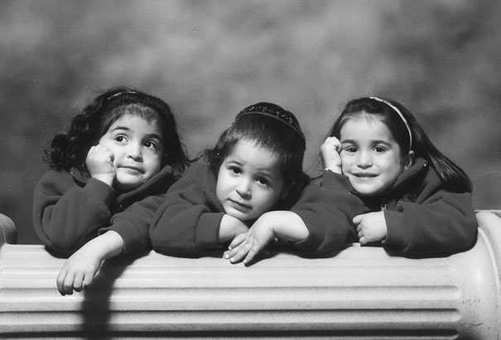The No Cry Discipline Solution (13 page)
Read The No Cry Discipline Solution Online
Authors: Elizabeth Pantley


50
No-Cry Discipline Parenting Skills and Tools
Father-Speak
“ I didn’t think for an instant that raising children would be
easy, but I also didn’t think it would be the emotional roller
coaster that it has been.”
—Alan, father to Leanne, age 3, and Timothy, age 5 months
Here’s the good news: There are very specifi c approaches that
work wonders to keep you calm and in control, help you make
good long-term decisions, and help you encourage your child to
willingly
cooperate with you. Using these methods will help your
day run more smoothly, and they will help you build a close, lov-
ing relationship with your children that can last a lifetime. These
methods also will allow you to live in the joy of the moment, since
you won’t be immersed in the juggling of all those issues involved
in daily survival.
A special side effect of using these approaches is that they will
actually prevent many of the tantrums, battles, and tears that can
spoil your day. By using these methods you are using
preventive dis-
cipline
. And the more consistent you are in using these approaches, the better your child’s daily behavior will be. Looking even farther
down the road, your child will more likely have solid self-discipline
patterns for the future.
Key Point
\You would be stunned to know how many negative behav-
iors you actually prevent from happening when you improve
the way you interact with your child.

Everyday Challenges
51
Miriam, age 4; Moshe, age 3; and Raizel, age 4
Keep in mind that as children grow they change. Certain skills
that work beautifully with toddlers often fall fl at with preschoolers
and only cause eye-rolling with older children. Some approaches
will work every single time with one child, yet never work at all
with his or her brother. In addition, parents are as different from
one another as children are, so some of the methods will work per-
fectly for one parent and fail miserably for the other. It takes some
experimentation to fi gure out what works best for you and your
family. But once you settle on a few specifi c ideas, you’ll feel more
confi dent and your home will be more peaceful. You’ll establish
routines and patterns that will allow you to make better short- and
long-term decisions over the next eighteen or more years.
Read through the techniques that follow, and think about the
various no-cry discipline methods that are described. You’ll see
that there is no one method prescribed for all families because
52
No-Cry Discipline Parenting Skills and Tools
every family is different and discipline tools should never be one-
size-fi ts-all. The beauty of having various options to choose from
is that by selecting those that fi t each particular parent/child pair
best, you can avoid the frustration and tears that result when
parents attempt to follow an outsider’s advice about what is best
for them. You know yourself and your child, so choose the ideas
that appeal to you, try them out, and gauge the results. Practice
and refi ne as you go. Eventually you’ll fi nd your own comfortable
rhythm and you’ll feel more confi dent and capable. Revisit this
book from time to time to fi ne-tune your actions, adjust them to
your growing child, and remind yourself of your goals. This active
style of parenting will make your parenting journey more joyful
as well as keep you on track to meet your long-term goals for your
child.

Often, when a child is stubborn, has a tantrum, fi ghts with
a sibling, whines, cries, or dawdles, the issue that sets off
the behavior has little to do with anything that requires an act
of discipline by the parent. Just as adults who are experiencing
a bad day, a bad mood, a headache, or some other personal issue
might snap at a spouse, yell at a child, or “kick the cat,” children
may be struggling with emotions or situations that cause them to
respond as they do. Responding to a child’s actions with knee-jerk
discipline often escalates the tantrum or tears. The problem will
not be addressed, and the lesson will not be learned. In essence,
the issue then is
not
always about how to discipline children but how to change the environment in order to help them gain control
over their emotions and reactions. By changing the environment
you can help a child calm himself down, thus opening the door to
a true learning experience.
In the following pages are some of the most common problems
that cause children to act out in negative ways, as well as some
solutions to guide you as you try to help your child cope. These
are all preventive, proactive, no-cry discipline processes, and they
may even help you prevent negative behavior.
The Problem: Tiredness
How much and how well a child sleeps has a role in
everything
from dawdling, crankiness, temper tantrums, and hyperactivity to physical growth, overall health, and the ability to learn to tie his or her
shoes and recite the alphabet.
Everything.
A sleep study completed at Tel Aviv University demonstrated that even a one-hour shortage
53
Copyright © 2007 by Better Beginnings, Inc. Click here for terms of use.





54
No-Cry Discipline Parenting Skills and Tools
in appropriate sleep time compromises a child’s behavior. Missed
naps, bedtimes that are too late, night wakings, or early risings can
cause unpleasant changes in your child’s daytime behavior.
This issue is further complicated because when children aren’t
sleeping, Mom and Dad aren’t sleeping either. We simply cannot
function well as parents—or, as a matter of fact, as people—when
our own sleep is continually disturbed. We become fatigued, and
